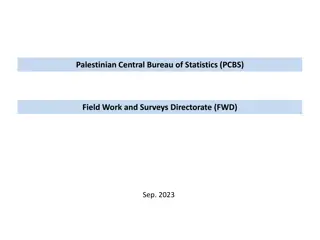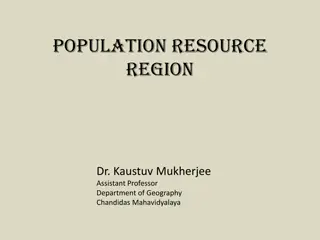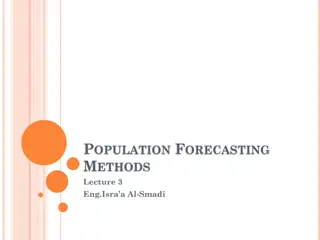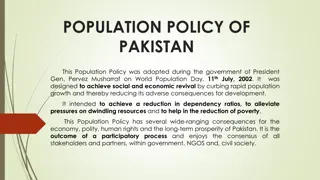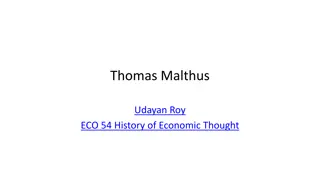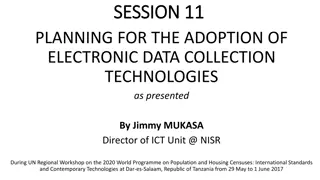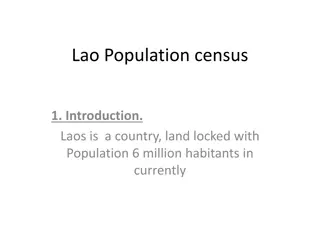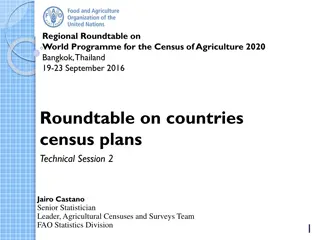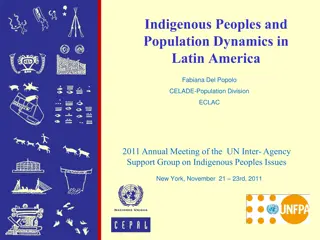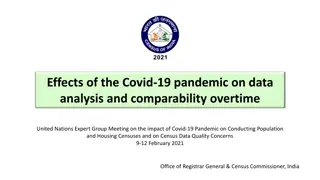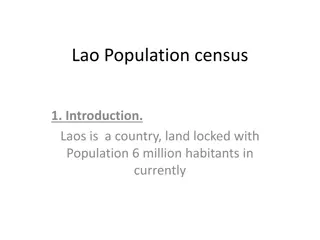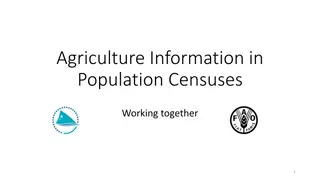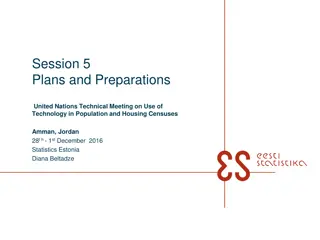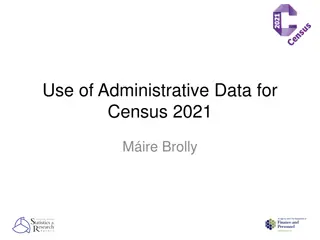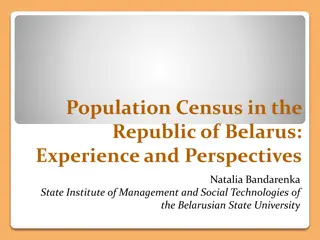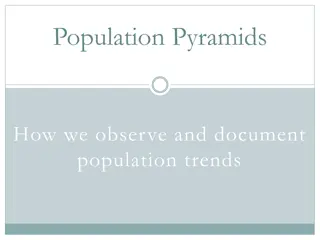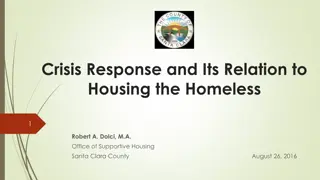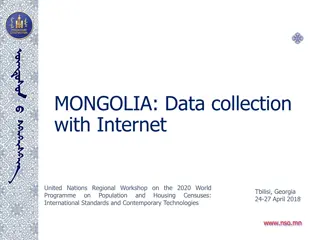Overview of the South African National Population Register
The South African National Population Register (NPR) is a vital system maintained by the Department of Home Affairs. It serves to record and update information on the country's resident population, issue identity documents, and handle related administrative tasks. The NPR has evolved over the years
2 views • 16 slides
Population and Housing Censuses Directorate - Midterm Review Mission Summary
The Population and Housing Censuses Directorate (PHCD) is actively involved in implementing various censuses, updating geographical databases, and conducting analytical studies. They are preparing for the next census in 2027 by learning from international experiences and modern methodologies. The di
0 views • 12 slides
Palestinian Central Bureau of Statistics Field Work and Surveys Directorate Overview
The Field Work and Surveys Directorate of the Palestinian Central Bureau of Statistics (PCBS) plays a crucial role in data collection, editing, coding, and management. They conduct various surveys and censuses, monitor data collection processes, and raise statistical awareness in the local community
2 views • 10 slides
Impact of Human Population Growth on Environment and Welfare
The rapid growth of the human population is placing immense pressure on the environment, leading to increased demand for resources like food, water, and shelter. The effects of human activity on the environment have escalated significantly over the years due to population expansion. High birth rates
1 views • 8 slides
Effective Census Planning for Successful Population and Housing Censuses
Census planning is crucial for the success of population and housing censuses, involving phases like questionnaire design, mapping, testing, enumeration, and data analysis. The link between these phases plays a vital role in the overall success of the census operation. The aim of census planning is
0 views • 24 slides
Introduction to Sampling in Statistics
Sampling in statistics involves selecting a subset of individuals from a population to gather information, as it is often impractical to study the entire population. This method helps in estimating population characteristics, although it comes with inherent sampling errors. Parameters represent popu
2 views • 24 slides
Population-Resource-Region Relationship: A Geographical Perspective
Explore the intricate relationship between population, resources, and regions through a geographical lens. Delve into classifications based on population, resources, and technology, with examples from different countries and regions. Discover the concepts of optimum population, over-population, and
2 views • 11 slides
Demography: Population Trends and Analysis
Demography is the study of population size, distribution, and composition, encompassing elements such as mortality, natality, migration, and demographic forces. Population census plays a crucial role in collecting and analyzing demographic data, with methods like De Jure and De Facto census. Inter-c
6 views • 21 slides
Comparing 1750 to 1900: Population Growth in Britain
The population of Britain saw a significant increase between 1750 and 1900. In 1750, the population was 7 million, and by 1900, it had grown to 37 million. This represented an 87% increase. The number of people living in towns also rose from 13% to a higher percentage. Factors contributing to this g
0 views • 6 slides
Population Resource Regions and Zelinsky's Classification
Geographers have long studied the relationship between population growth and resource adequacy, leading to the concept of Population Resource Regions (PRR) by W. Zelinsky. Zelinsky identified five types of PRR based on population-resource ratios, ranging from Type A with high resource utilization po
0 views • 8 slides
Population Distribution in Different Regions of Pakistan
The population distribution in Pakistan varies significantly among different regions, with certain provinces like Punjab and Sindh having higher population densities compared to Baluchistan and FATA. The rural areas are also categorized into different population density regions based on the number o
0 views • 14 slides
Effective Management Systems for Field Enumeration in Population and Housing Censuses
Management Information Systems and tools play a crucial role in monitoring and managing field enumeration activities during population and housing censuses. Real-time monitoring of enumeration status, quality control measures, and data transmission to headquarters are essential for a successful enum
0 views • 13 slides
Enhancing Population and Vital Statistics in Botswana: Insights from Expert Group Meeting
Explore Botswana's efforts in improving population and vital statistics through autonomous bodies and decennial censuses, like the upcoming 2021 census. Learn about demographic indicators and population counts shaping the country's data collection methods.
5 views • 11 slides
Methods of Population Forecasting for Urban Development
Designing water supply and sanitation schemes for cities requires accurate population forecasting. Factors influencing population changes include births, deaths, migration, and annexation. Various methods like Arithmetic Increase, Geometric Increase, and Ratio Method are used to predict population g
4 views • 24 slides
Population Policy of Pakistan: Vision, Goals, and Strategies
The Population Policy of Pakistan, adopted in 2002, aims to stabilize the population by 2020 through a focus on reducing fertility rates and promoting family planning. The policy outlines goals such as achieving a balance between resources and population, increasing awareness of rapid population gro
0 views • 11 slides
Thomas Malthus and His Theory on Population Growth
Thomas Robert Malthus, an influential economist, proposed a theory on population growth in the 18th century. His theory suggested that population grows exponentially while food production increases at a slower rate, leading to inevitable food scarcity. Malthus also discussed the concept of preventiv
2 views • 19 slides
Adoption of Electronic Data Collection Technologies in Population Census Planning
Presentation by Jimmy Mukasa at a UN Regional Workshop focusing on the adoption of electronic data collection technologies for the 2020 World Programme on Population and Housing Censuses. The discussion includes past experiences, future plans, advantages of using Computer-Assisted Personal Interview
0 views • 22 slides
Overview of Laos Population Census Methods and Trends
Laos, a landlocked country with a population of 6 million inhabitants, conducts its population census using the De Jure method. Demographic data is collected through a variety of methods including vital registration and actuarial methods due to poor registration in rural and ethnic areas. Quality ma
0 views • 7 slides
Overview of Agricultural Census Participation in Asian Countries
This text highlights the participation of Asian countries in agricultural censuses during the World Programme for the Census of Agriculture (WCA) rounds in 2010 and planned for 2020. It provides insights into the countries that conducted agricultural censuses, their respective plans for the upcoming
1 views • 14 slides
Regional Roundtable on World Programme for the Census of Agriculture 2020
The Regional Roundtable held in Port of Spain, Trinidad and Tobago in May 2017 focused on countries' census plans for the World Programme for the Census of Agriculture. The event discussed participation statistics, census rounds, and the status of FAO Caribbean countries in conducting agricultural c
0 views • 13 slides
Louisiana Parish Population Statistics 2010
Louisiana Parish Population Statistics for the year 2010 reveal varying population numbers across different regions. The data provides insights into demographic changes and trends over the past decade. The total population change by parish and age group highlights shifts in different age brackets. T
0 views • 42 slides
Improvement of Population and Vital Statistics Metadata in the Demographic Yearbook System
The Demographic Yearbook system focuses on enhancing population and vital statistics metadata to ensure accurate and concise reflection of population concepts across 230+ countries. It involves annual collection of official national population estimates, vital statistics, and UN international travel
0 views • 16 slides
Indigenous Peoples and Population Dynamics in Latin America
Latin America is a region with diverse indigenous groups, facing demands for recognition and rights. The importance of information, especially from censuses, is crucial for developing policies and programs to support indigenous peoples. Various data sources such as censuses, surveys, and registries
0 views • 19 slides
Impact of Covid-19 on Census Data Analysis: Insights from the UN Expert Group Meeting
The Covid-19 pandemic has significantly affected data analysis and comparability over time, particularly in the context of population and housing censuses. This impact was discussed at the United Nations Expert Group Meeting in February 2021, focusing on the challenges faced in conducting these cens
0 views • 16 slides
Overview of Population Census in Laos
Laos, a landlocked country with a population of 6 million, has conducted multiple population censuses since 1985. The methodologies used include the De Jure Census method. Demographic methods involve indirect techniques due to poor vital registration. Quality management emphasizes supervision and co
0 views • 7 slides
Importance of Agriculture Information in Population Censuses
Agriculture data in population censuses is crucial for understanding socio-economic dynamics, food security, and rural development. It aids in policy analysis, demographic insights, poverty reduction strategies, gender roles, and overall development monitoring. Utilizing existing agriculture informa
0 views • 13 slides
Logistic Growth in Population Dynamics
Explore the logistic growth equation and its applications in modeling population dynamics. Dive into the concept of sigmoidal growth curves and the logistic model, which reflects population growth with limits. Learn how to calculate population change using the logistic growth equation and understand
1 views • 26 slides
Evolution of Population and Housing Censuses in Sweden (1990-2011)
Transitioning from traditional questionnaire-based methods, Sweden evolved its population and housing censuses towards register-based systems between 1990 and 2011. The shift allowed for continuous updates, improved statistics, and laid the groundwork for future census practices, such as the creatio
0 views • 19 slides
Overview of Population Measures and District Data from Census Reports
The census reports various population measures including total population, voting age population, and citizen voting age population. The data includes breakdowns by ethnicity for each trustee district. Changes in voting and citizen voting age population percentages are also provided. Data is sourced
1 views • 4 slides
United Nations Technical Meeting on Use of Technology in Population and Housing Censuses
Session 5 Plans and Preparations for the United Nations Technical Meeting on Use of Technology in Population and Housing Censuses held in Amman, Jordan from 28th November to 1st December 2016. The session covered topics such as timetable of Population and Housing Census 2011, training programs for s
0 views • 58 slides
Utilizing Administrative Data for Census 2021: Insights and Strategies
Providing a comprehensive overview of the historical use of administrative data for census purposes, this content delves into methodologies adopted in previous censuses, such as hand-delivery, online attempts, and administrative data enrichment. It also outlines plans for the 2021 census, focusing o
0 views • 19 slides
Population Census in the Republic of Belarus: History, Principles, and Significance
The Population Census in the Republic of Belarus has a rich history, with nine previous counts conducted since 1897. This census provides essential demographic data, including information on sex, age, nationality, education, marital status, and more. The census program in Belarus is based on fundame
0 views • 26 slides
Insights from United Nations Regional Workshop on Population and Housing Censuses
Highlights from the United Nations Regional Workshop on the 2020 World Programme on Population and Housing Censuses in Tbilisi, covering topics such as disability data collection challenges, deriving population with usual residence, and measuring SDGs through census data.
0 views • 20 slides
Population Pyramids for Analyzing Population Trends
Population pyramids are graphical illustrations that showcase the distribution of age groups within a population, segmented by gender. By observing and documenting the patterns of population pyramids, one can discern trends such as rapid growth, slow growth, or negative growth, which are influenced
0 views • 7 slides
Overview of Recommended Population and Housing Census Topics in Liberia
The Liberian participants have presented recommended topics for the population and housing census, outlining the history of census-taking in Liberia and detailing the specific topics covered in the 2008 National Population and Housing Census. The census topics include identification particulars, pop
0 views • 11 slides
Crisis Response and Housing for the Homeless in Santa Clara County
This document discusses the crisis response and housing initiatives for the homeless population in Santa Clara County. It covers statistics from homeless censuses and surveys, community plans to end homelessness, care coordination projects, the cost of homelessness in Silicon Valley, and innovative
0 views • 11 slides
Impacts of COVID-19 on Population and Housing Censuses: Challenges and Solutions
The COVID-19 pandemic has disrupted the implementation of population and housing censuses worldwide, leading many countries to postpone or modify their census operations. National Statistical Offices faced challenges in conducting traditional field-based censuses as scheduled in 2020 and 2021. The U
0 views • 13 slides
Data Collection with Internet for Censuses in Mongolia
The data collection in Mongolia for censuses has evolved with the implementation of internet-based tools, such as the E-Census and E-Registration systems. These innovations have allowed for more efficient population and housing censuses, including surveys of citizens residing abroad. The aim of thes
0 views • 32 slides
Maine Workforce and Population Trends Analysis 2014-2024
Maine's workforce and population outlook from 2014 to 2024 reveals a decline in births, resulting in an aging population and workforce imbalance. The state faces challenges due to low birth rates, negative natural population change, and minimal net migration, impacting labor force growth and total p
0 views • 31 slides
The Global Human Population Explosion: Causes and Implications
The lecture explores the rapid increase in the global human population post-World War II, analyzing factors such as birth rates, mortality rates, and life expectancy. Various counterarguments are presented, including the debate on population growth benefits, ethical concerns over reproductive interf
0 views • 20 slides


